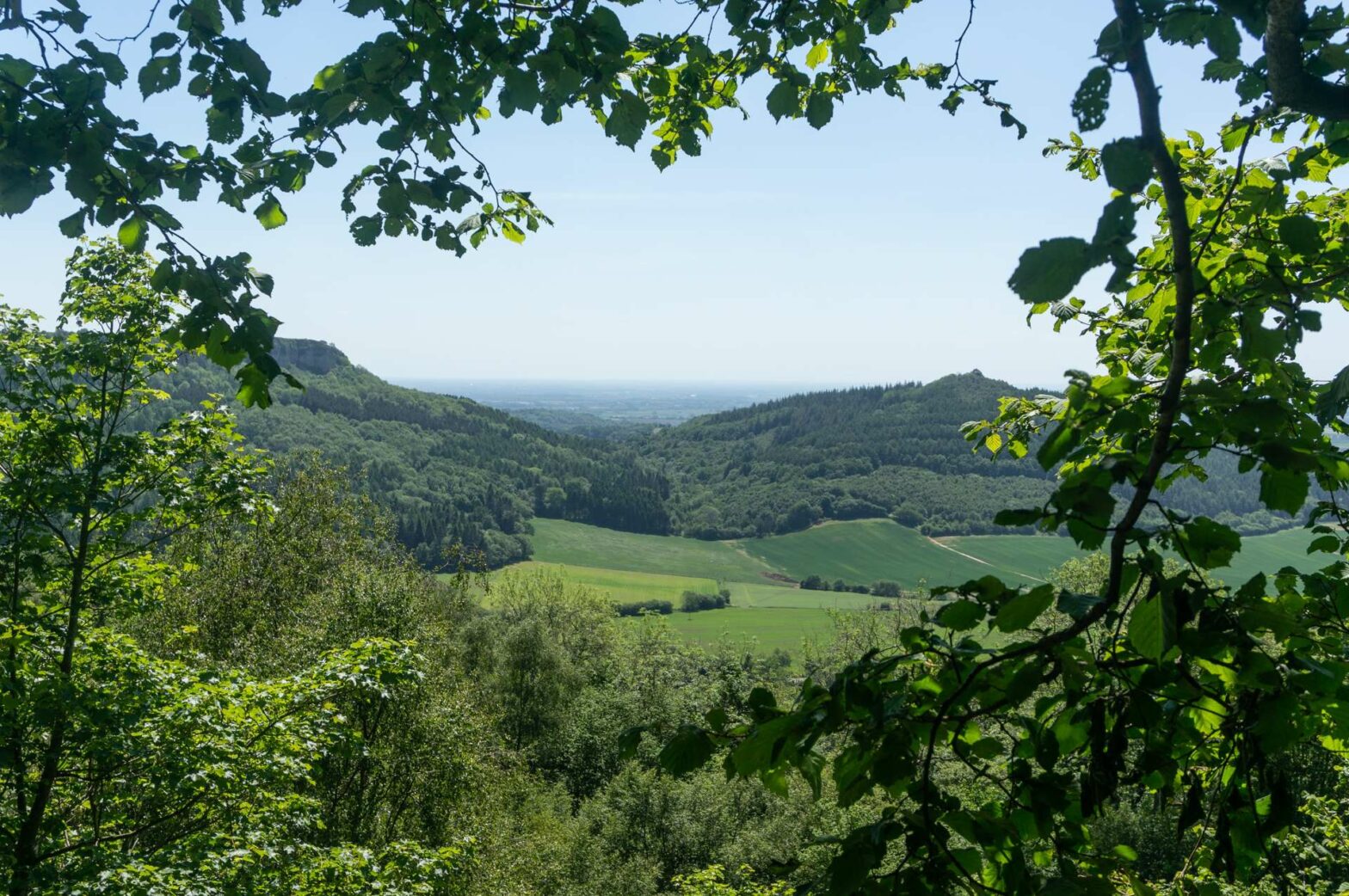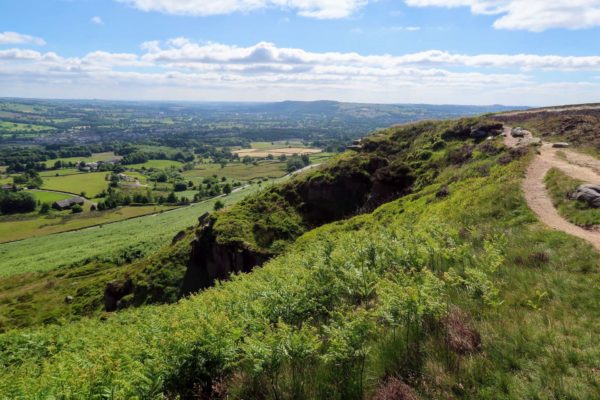By Vicky · Published Sep. 12th, 2023
When you buy through links highlighted with an asterisk (*) on this site, we may earn a small affiliate commission at no cost to you.
This glorious walk at Sutton Bank leads you to the Kilburn White Horse, the Finest View in England and Gormire Lake.
Location
This walk starts from the Sutton Bank National Park Centre. There are two large car parks on either side of the centre, both £5.50 for the day. It’s about 1 hour’s drive from Leeds, or 40 minutes from York or Middlesborough.
Sutton Bank Walking Map
Get the route by downloading the .gpx or .kml file below. For navigation with Maps.me on your mobile phone, simply download the .kml file and open to add it to the Maps.me bookmarks.
Tips
- At the Sutton Bank National Park Centre where this walk starts, you can pick up free maps and leaflets about the surrounding area.
- There’s also a cafe at the park centre.
- The map to take for this hike is the Ordnance Survey Explorer OL26 of the North York Moors*.
- For other hikes nearby, try the short hikes up Beamsley Beacon, Almscliffe Crag, Sharp Haw and Flasby Fell, or Embsay Crag.
- You can find other Yorkshire ideas in our Yorkshire Guide.
Sutton Bank Walking Route
This walk at Sutton Bank starts from the visitor’s centre. First, head towards and cross the main road onto the obvious path. From here there’s an easy paved path along the top of the cliffs all the way to the Kilburn White Horse.
Walking to Kilburn White Horse
While walking along you’ll have great views to your right, and see lots of little planes on your left. The Yorkshire Gliding Club is based on the plateau at the top of the cliffs here. It’s a great location because the gliders need a flat surface to take off from, but they also start higher up and can catch the updrafts coming up from the cliffs.
Once you get to the other side of the gliding club, you’ll be standing at the top of the white horse, with some fantastic views. To actually see the white horse, head down the many steps at the far side of the horse to the car park at the bottom. It’s actually quite hard to see from so close up. You can walk several metres away from the hillside to try and get the best views.
Kilburn White Horse was created in 1857 and is the largest white horse in England. To form the horse, the layer of topsoil was removed and then filled in with white limestone chips. When you’ve finished admiring the horse, head left (when looking at the horse) along the flat path from the car park.
Keep walking along this trail as it contours around the hillside and keep right at the junctions to return to the top plateau. Once here, turn left and you’ll soon be back near the visitor’s centre.
How was Sutton Bank created?
During the last Ice Age (100,000 to 10,000 years ago), a glacier flowed along the western edge of the North York Moors. As it moved slowly down the valley, it scraped out the soft rock beneath and on either side of it. This left the dramatic cliffs you see at Sutton Bank today.
The Finest View in England
Don’t walk all the back to the centre, instead turn left as soon as you’ve crossed the road. In about 200 metres you’ll be at the famous viewpoint, known as the finest view in England. It was first called this by James Herriot, the Yorkshire Vet. On clear days you can see the plateau of the Gliding Club and the cliffs below, the flat plains of Yorkshire and the Yorkshire Dales in the far distance. You can also see Gormire Lake far below.
Once you’ve admired the viewpoint, continue along the clifftop path. Walk along here for about 3 km, with great views to your left for most of the way. You’ll also pass some obvious rocky cliffs along the route and some lovely fields of wheat.
After almost 3 km, take the small path leading downwards between the embankments. The path bends a corner and heads directly down the slope, across a small lane. At the next T-junction turn left along the bottom of the woods and into the fields.
Gormire Lake
The path leads through open fields and cute farms, then between two hills. At the other side of the gap between the hills, the path leads downwards to the edge of Gormire Lake. There is a trail all the way around the lake, but it’s mainly in the trees and you can only see the lake itself from a few locations.
Once you’ve walked about halfway along the lake’s edge, take the path heading left and uphill. This takes you back to the plateau at the top of the cliffs. It’s quite a way upwards but mainly shaded from the sun.
Turn right when you get to the path at the top. To take a slightly different way back to the car park, head left just before the Finest View in England lookout. This path winds through Cliff Plantation, a rather open area of moorland. You’ll meet the road on the other side. Cross over to the car park and perhaps have a drink in the cafe before leaving. This is the end of the Sutton Bank Walk.
The Rough Guide to Yorkshire* is a great little guidebook and has a section on Ilkley and things to do nearby. The Yorkshire Dales Pathfinder Guide* has a good collection of short hikes suitable for the entire family and the Guide to North Yorkshire Pub Walks* has some fun walks in the Dales for those who are hungry and thirsty.
For other short countryside hikes nearby, why not walk up Almscliffe Crag, Sharp Haw and Flasby Fell, Beamsley Beacon, or Embsay Crag.
FAQS: Sutton Bank Walk
You can go on walks of varying lengths at Sutton Bank. If you just want to walk to the famous viewpoint, it’s almost 1 km return. To walk to the White Horse and back is about 5km, while to explore the viewpoint, white horse, cliffs and Gormire Lake the walk is about 14 km.
Sutton Bank is in North Yorkshire on the edge of the North York Moors National Park. It’s about 1 hour north of Leeds and 40 minutes south of Middlesborough.
You can walk around Lake Gormire and the loop is about 1km, but you can’t see too much of the lake itself because the path is in the surrounding trees. You can only see the lake at a view places along the loop.
During the last Ice Age (100,000 to 10,000 years ago), a glacier flowed along the western edge of the North York Moors. As it moved slowly down the valley, it scraped out the soft rock beneath and on either side of it. This left the dramatic cliffs you see at Sutton Bank today.








